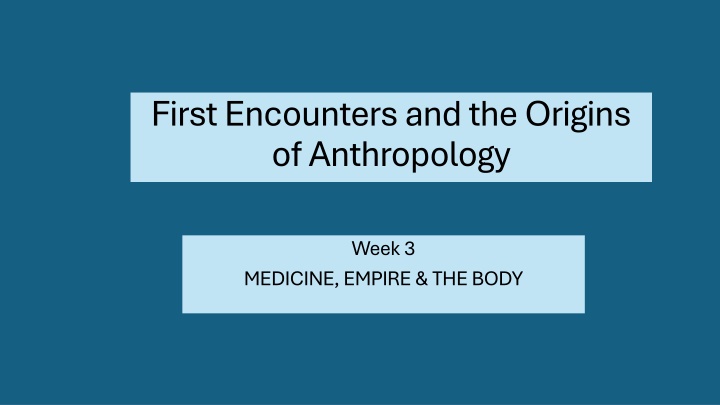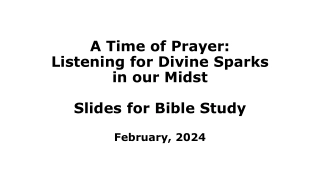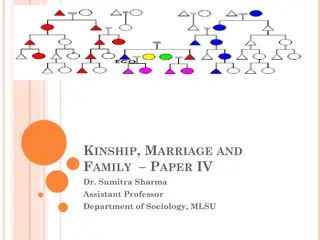
Origins of Racial Ideology and Gender Stereotyping in Early Encounters
Explore the development of racial ideology and gender stereotypes through the first encounters between Europeans and Indigenous Americans, shaping attitudes towards race, gender, and civilization. Discover how print culture fueled the emergence of racial hierarchies, the gendering of racial ideology, and the shift from nation-centric to race-based classification through the 18th century. Unravel the complex interplay between race, gender, and colonialism that defined early anthropological perspectives.
Download Presentation

Please find below an Image/Link to download the presentation.
The content on the website is provided AS IS for your information and personal use only. It may not be sold, licensed, or shared on other websites without obtaining consent from the author. If you encounter any issues during the download, it is possible that the publisher has removed the file from their server.
You are allowed to download the files provided on this website for personal or commercial use, subject to the condition that they are used lawfully. All files are the property of their respective owners.
The content on the website is provided AS IS for your information and personal use only. It may not be sold, licensed, or shared on other websites without obtaining consent from the author.
E N D
Presentation Transcript
First Encounters and the Origins of Anthropology Week 3 MEDICINE, EMPIRE & THE BODY
Overview First encounters between Europeans and Indigenous Americans shaped attitudes towards gender and race . The inhabitants of different geographic areas began to be stereotyped both appearances and behaviours were generalised. The hardening of race as a biological concept and emergence of racial hierarchies emerged in the context of slavery and imperial expansion.
Some Could Suckle over Their Shoulder: Male Travelers, Female Bodies and the Gendering of Racial Ideology, 1500-1700 Jennifer L. Morgan Morgan argues that the meanings of the Black female body were inscribed long before colonialism. The gendering of racial ideology appeared frequently in books ( like Edward Long s The History of Jamaica) and art ( like the plates in Theodore de Bry s Small Voyages). The way that Amerindians and Black people were presented in these varied, but they frequently included themes of cannibalism, infant murder and the bestial tendencies of women. White male travellers presented Black and Amerindian bodies as both repulsive and desirable. Travellers often wrote about the childbearing capacity of Amerindian and Black women. They claimed that they did not feel pain when giving birth, therefore they were more like beasts than humans. In the case of Black women, being able to sidestep the curse of Eve meant they were not truly human and therefore could be enslaved. Morgan states that she does not think that the category of gender was more important than race. However However, racialist discourse was defined by its ideas about gender and sexual difference. Quote: the encounter had already taken place in the parlors and reading rooms on English soil, assuring that colonists would arrive with a battery of assumptions and predispositions about race, femininity, sexuality and civilisation [pg.191]
From Nation to Race: The Origin of Racial Classification in Eighteenth Century Thought Nicholas Hudson Quote: Quote: Before these authors, racism could exist as little more than a visceral distrust of physical difference, crudely expressed in degrading images and outbursts of disgust. Only with the rise of racial science could racism take the form of an objective and self-conscious conviction in the racial inferiority of certain visibly different groups [pg.252] Pre-18th century ethnographic literature was dominated by the subject of political, social and cultural sophistication. The people of different kingdoms and cities were seen to have their own unique character, and the focus was more on nation than race. However However, African peoples were still generalised and seen as uniformly savage and homogenous. Native American peoples were seen to be more diverse, but less so than the diversity between European peoples. 18th century onward the focus shifted to descriptors of races. They generalised continental groups as races and extensively documented their supposedly racially inherent characteristics (both physical and mental). Enlightenment naturalists often disagreed about the status of man in relation to the animal kingdom in their quest to define the different racial groups. Some, like Buffon, reflected the uniqueness of humanity in their work. Those like Linn , by stating that humans could be categorised into species like plants and animals, implied that humanity did not have a unique place in the natural world. We have yet to fully abandon Enlightenment racial science. And the closeness of race and nation proved problematic in the 20th century, and they continue be a tool of the Far-Right to this day. Question: Question: How did print culture facilitate the development of racial ideology?
Savages Noble and Ignoble: the Preconceptions of Early European Voyages in Polynesia I. C. Campbell The idea that the peoples of the Pacific were idealized as Noble Savages was supposedly widespread and drawn from experience, but appears to be more of a preoccupation of historians than an accurate assessment of contemporary beliefs. Instead, Tahitians and other Polynesian groups were only partially romantised in the writings of naturalist explorers like Bourgainville, Banks, and Foster. Negative behaviours such as treachery, thievery, and cannibalism also featured heavily in early travellers accounts, shipwreck narratives, etc. Idealised depictions of Noble Savages as pure, childlike, hospitable mostly a product of intellectual armchair/salon culture in Europe, not actual encounters with Pacific Islanders. Two contradictory images of Pacific peoples thus emerged, representing the noble and the savage , and reflect different impulses towards supposedly uncivilised peoples: to preserve or eradicate them, to idealise or condemn them. Quote: Quote: References to islanders being savage and treacherous cannibals outnumber references to them as being something akin to hospitable children of nature by at least six to one. (p.53)
Natural Philosophy and an Early Racial Idiom in North America: Comparing English and Indian Bodies Joyce E. Chaplin Natural philosophy provided an explanatory model for physical differences prior to the development of biological racism, and linked propensity to disease to constitution and climate. In early colonial America, English settlers understood their dominance of the territory in corporeal terms: they seemed to be physically well adapted to the environment. Meanwhile, they observed the Indigenous population suffering terribly from diseases, which they initially believed to be local in origin (rather than imported). Increasingly, the English became increasingly convinced of Native American bodily inferiority; they were worse at surviving in their own climate than English settlers, who were thriving by comparison. The English ultimately dispossessed Indigenous Americans of their own land; suggesting they were poorly adapted migrants from abroad while the English were physically foreordained to inhabit the territory. Quote: Quote: By applying the language of natural philosophy to Native American attrition and English vigour, the colonists defined a new idiom: that the significant human variation in North America was not due to external environment but instead lay within the bodies of its European and Indian peoples. (p.231)
Introduction: The 1741 Contest on the Degeneration of Black Skin and Hair Henry Louis Gates, Jr. and Andrew S. Curran Quote Quote: As naturalists and savants freed themselves from the imperatives of Scripture, they increasingly attributed the origins of human phenotypes to purely material or physical causes. (p. 7) In 1741, the Royal Academy of Sciences of Bordeaux ran an essay prize competition on the question what is the physical cause of the Negro s colour, the quality of their hair, and the degeneration of both? 16 essays were received, although no prize was awarded. Bordeaux had significant financial investments in the slave colony of St Domingue (especially sugar), explaining why such a topic constituted useful knowledge for the city s elites. The competition entries reflected both religious and scientific approaches to the study of human difference, demonstrating that the mid-C18 was a period of transition from divine to secular explanations for natural phenomena. Responses alluded to theoretical beliefs (particularly in monogenism and racial degeneration) as well as empirical evidence (direct observation, and in some cases, autopsies). A further competition in 1772 on how best to preserve the health of Africans during their crossing to the New World equally explored the nature of racial difference, but the link to slavery was now far more explicit and reflected the development of racial taxonomies in the late C18. Question: Question: How did explanations of human difference change across the eighteenth century and why?






















